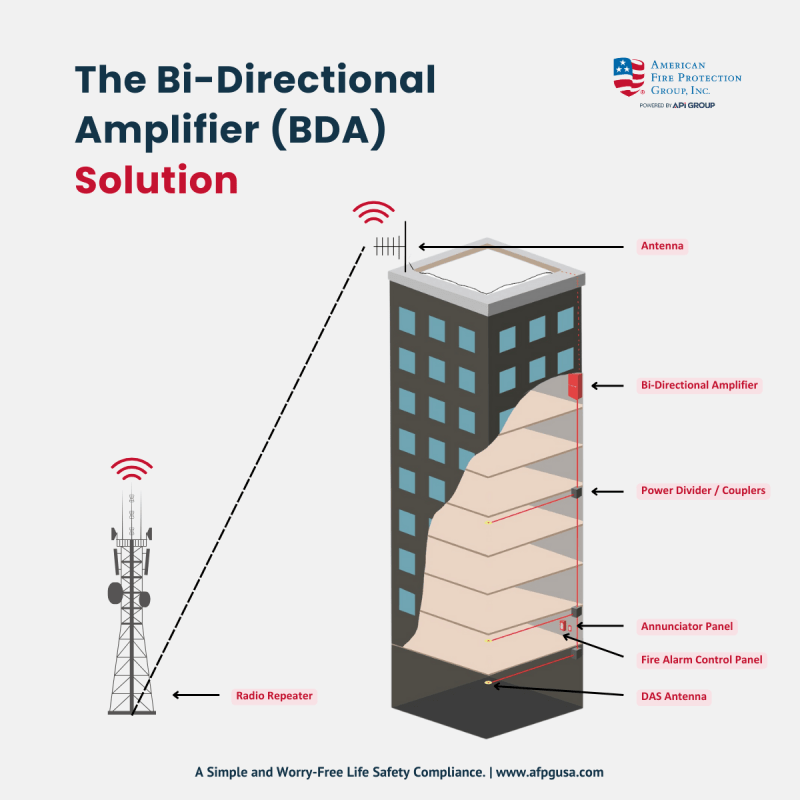The Importance of Bi-Direction Amplifier (BDA) Systems

Effective communication is critical in any building, especially during emergencies when every second counts. A key technology enabling this safety is the Bi-Directional Amplifier (BDA) system. Designed to boost emergency communication and public safety radio signals within challenging environments. In this blog, we’ll cover what a BDA is, its essential benefits, which buildings need one, and why American Fire Protection Group (AFPG) is your trusted partner for BDA needs. Whether you are navigating permit requirements or seeking solutions to improve building safety, American Fire Protection Group (AFPG) is here to provide the expertise and systems you need to protect lives and property.
What is a Bi-Directional Amplifier (BDA) System?
A Bi-Directional Amplifier (BDA) is a signal-boosting device that enhances two-way radio communication inside buildings and hard-to-reach spaces like stairwells, underground tunnels, and parking garages. BDAs are the core of Emergency Radio Communication Enhancement Systems (ERCES). They amplify radio frequency (RF) signals in both uplink (building to radio network) and downlink (network to building) directions. By improving radio coverage, it ensures reliable emergency communication between responders and occupants in any situation.

Why do you need a BDA?
During emergencies, reliable communication is vital for life safety and property protection. A Bi-Directional Amplifier (BDA) system plays a crucial role in maintaining clear radio transmissions between first responders inside a building and emergency personnel outside, overcoming obstacles like concrete, metal, and other structural barriers that weaken in-building radio signals.
Key Benefits of a BDA System:
- Peace of Mind: Integrating a BDA ensures your building supports emergency responders, ensuring seamless communication during critical situations and helping create a safer environment.
- Reliable Communication: BDA systems reduce dead spots, providing clear, dependable communication – which is crucial for coordination during emergencies.
- Targeted Signal Enhancement: BDAs are engineered to amplify specific frequency bands without altering signal integrity – preserving the quality of inbound and outbound transmissions.
- Compliance and Integration: As a life-saving infrastructure, BDAs are typically installed alongside Fire Alarm Systems, monitored by supervisory signals, and must adhere to IBC/NFPA standards.
Which buildings need a Bi-Directional Amplifier (BDA) System?
Many jurisdictions require certain buildings to install a BDA system to ensure public safety communications meet code and permit standards – especially for new construction or renovations. For the latest regulations, refer to the ICC International Building Code. Typical facilities needing in-building signal enhancement include:
- Airport Terminals
- Apartment Complexes and High Rises
- Commercial buildings
- Hospitals and Healthcare Facilities
- Hotels
- Parking Garages
- Schools, Colleges, and Campuses
If you’re unsure about your local public safety communication code requirements, consult your municipality or Fire Department for specific regulations.
Why should you choose AFPG?
American Fire Protection Group (AFPG) is your trusted partner for providing Bi-Directional Amplifier (BDA) systems. From consultation to installation, we are committed to delivering tailored solutions that ensure uninterrupted communication when it matters most. Choose AFPG to equip your building with the essential communication enhancement systems designed to protect lives, ensure compliance, and meet the demands of safety standards. Reliable communication starts with AFPG. Contact Us Today!